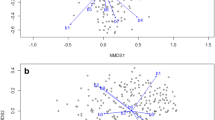Abstract
House mouse lines bidirectionally selected for either nest-building behavior or attack latency were tested for both attack latency and nest-building behavior under identical conditions. Male mice selected for high nest-building behavior had shorter attack latencies, i.e., were more aggressive, than those selected for low nest-building behavior and their randomly bred control lines. Conversely, male wild house mice selected for short attack latency showed more nest-building behavior than those selected for long attack latency when tested at 110 days of age. These findings imply a common genetic basis for control of aggression and nesting and support earlier proposals as to how animals may exhibit fundamentally different responses to environmental challenges, either reacting actively to aversive situations (aggressive and high-nesting animals: active copers) or adopting a passive strategy (nonaggressive and low-nesting animals: passive copers).
Similar content being viewed by others
References
Barkley, M. S., and Goldman, B. D. (1977a). A quantitative study of serum testosterone, sex accessory organ growth, and the development of intermale aggression in the mouse.Horm. Behav. 8:208–218.
Barkley, M. S., and Goldman, B. D. (1977b). The effects of castration and silastic implants of testosterone on intermale aggression in the mouse.Horm. Behav. 9:32–48.
Benus, R. F., Koolhaas, J. M., and van Oortmerssen, G. A. (1988). Aggression and adaptation to the light-dark cycle: Role of intrinsic and extrinsic control.Physiol. Behav. 43: 131–137.
Benus, R. F., Den Daas, S., Koolhaas, J. M., and van Oortmerssen, G. A. (1990). Routine formation and flexibility in social and non-social behaviour of aggressive and nonaggressive mice.Behaviour 112:176–193.
Benus, R. F., Bohus, B., Koolhaas, J. M., and van Oortmerssen, G. A. (1991). Heritable variation for aggression as a reflection of individual coping strategies.Experientia 47: 1008–1019.
Bignami, G. (1965). Selection for high rates and low rates of avoidance conditioning in the rat.Anim. Behav. 13:221–227.
Bohus, B., Benus, R. F., Fokkema, D. S., Koolhaas, J. M., Nyakas, C., van Oortmerssen, G. A., Prins, A. J. A., de Ruiter A. J. H., Scheurink, A. J. W., and Steffens, A. B. (1987). Neuroendocrine states and behavioral physiological stress responses. In de Kloet, E. R., Wiegant, V. M., and de Wied, D. (eds.),Progress in Brain Research, Vol 72, Elsevier, Amsterdam, pp. 57–70.
Brush, F. R. (1991). Genetic determinants of individual differences in avoidance learning: Behavioral and endocrine characteristics.Experientia 47:1051–1056.
Bult, A. (1993)An Analysis of Quantitative Genetic, Neural, and Circadian Aspects of Thermoregulatory Nest-Building Behavior in the House Mouse, Ph.D. thesis, Wesleyan University, Middletown, CT.
Bult, A., Van der Zee, E. A., Compaan, J. C., and Lynch, C. B. (1992). Differences in the number of arginine-vasopressin-immunoreactive neurons exist in the suprachiasmatic nuclei of house mice selected for differences in nest-building behavior.Brain Res. 578:335–338.
Bult, A., Hiestand, L., Van der Zee, E. A., and Lynch, C. B. (1993). Circadian rhythms differ between selected mouse lines: A model to study the role of vasopressin neurons in the suprachiasmatic nuclei.Brain Res. Bull. 32:623–627.
Catlett, R. H. (1961). An evaluation of methods for measuring fighting behavior with special reference toMus musculus.Anim. Behav. 9:8–10.
Cools, A. R., Brachten, B. R., Heeren, D., Willemen, A., and Ellenbroek, B. (1990). Search after neurobiological profile of individual-specific features of Wistar rats.Brain Res. Bull. 24:49–69.
Crabbe, J. C., Phillips, T. J., Kosobud, A., and Belknap, J. K. (1990). Estimation of genetic correlation: Interpretation of experiments using selectively bred and inbred animals.Alcohol Clin. Exp. Res. 14:141–151.
Driscoll, P., and Bättig K. (1982). Behavioral emotional and neurochemical profiles of rats selected for extreme differences in active, two-way avoidance performance. In Lieblich, I. (ed.),Genetics of the Brain, Amsterdam, Elsevier Biomedical Press, 1982, pp. 95–123.
Driscoll, P., Dedek, J., D'Angio M., Claustre, Y., and Scatton, B. (1990). A Genetically-based model for divergent stress responses: Behavioral, neurochemical and hormonal aspects,Adv. Anim. Breed. Genet. 5 (Suppl.):97–107.
Duncan, D. B. (1955). Multiple range and multiple F tests.Biometrics 11:1–42.
Henry, J. P., and Stephens, P. M. (1977).Stress, Health and the Social Environment: A Sociobiological Approach to Medicine, Springer Verlag (JED), New York.
Laffan, E. A. (1989).Artificial Selection for Thermoregulatory Nest-Building in the House Mouse: Analysis of the Lines and Their Limits, Ph.D. thesis, Wesleyan University, Middletown, CT.
Lynch, C. B. (1980). Response to divergent selection for nesting behavior inMus musculus.Genetics 96:757–765.
Lynch, C. B. (1992). Clinal variation in cold adaptation inMus domesticus: Verification of predictions from laboratory populations.Am. Nat. 139:1219–1236.
Norusis, M. J. (1988).SPSS/PC+Advanced Statistics V2.0, SPSS Inc.
van Oortmerssen, G. A., and Bakker, T. C. M. (1981). Artificial selection for short and long attack latencies in wildMus musculus domesticus.Behav. Genet. 11:115–126.
van Zegeren, K. (1980). Variation in aggressiveness and the regulation of numbers in house mouse populations.Neth. J. Zool. 30:635–770.
Author information
Authors and Affiliations
Rights and permissions
About this article
Cite this article
Sluyter, F., Bult, A., Lynch, C.B. et al. A comparison between house mouse lines selected for attack latency or nest-building: Evidence for a genetic basis of alternative behavioral strategies. Behav Genet 25, 247–252 (1995). https://doi.org/10.1007/BF02197183
Received:
Accepted:
Issue Date:
DOI: https://doi.org/10.1007/BF02197183




